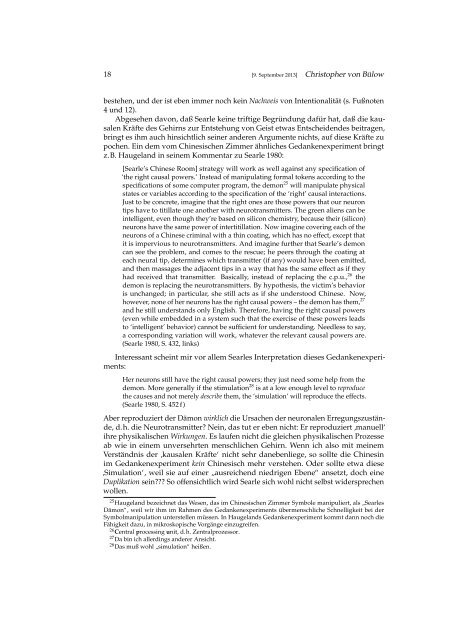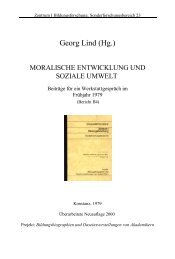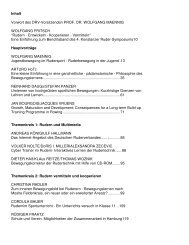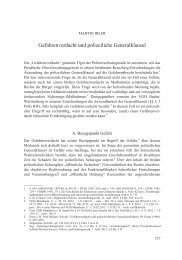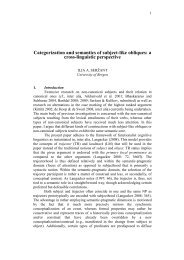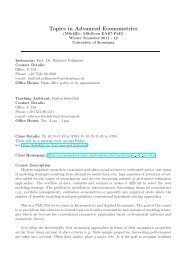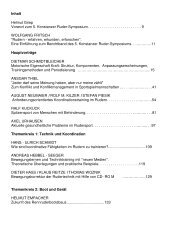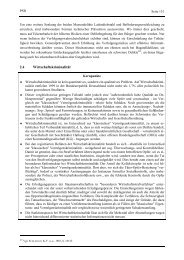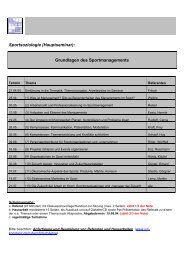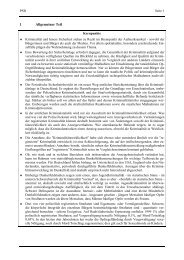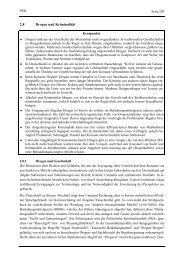Chinesische Zimmer, Turnhallen und Gehirne - Universität Konstanz
Chinesische Zimmer, Turnhallen und Gehirne - Universität Konstanz
Chinesische Zimmer, Turnhallen und Gehirne - Universität Konstanz
Erfolgreiche ePaper selbst erstellen
Machen Sie aus Ihren PDF Publikationen ein blätterbares Flipbook mit unserer einzigartigen Google optimierten e-Paper Software.
18 [9. September 2013] Christopher von Bülow<br />
bestehen, <strong>und</strong> der ist eben immer noch kein Nachweis von Intentionalität (s. Fußnoten<br />
4 <strong>und</strong> 12).<br />
Abgesehen davon, daß Searle keine triftige Begründung dafür hat, daß die kausalen<br />
Kräfte des Gehirns zur Entstehung von Geist etwas Entscheidendes beitragen,<br />
bringt es ihm auch hinsichtlich seiner anderen Argumente nichts, auf diese Kräfte zu<br />
pochen. Ein dem vom <strong>Chinesische</strong>n <strong>Zimmer</strong> ähnliches Gedankenexperiment bringt<br />
z.B. Haugeland in seinem Kommentar zu Searle 1980:<br />
[Searle’s Chinese Room] strategy will work as well against any specification of<br />
‘the right causal powers.’ Instead of manipulating formal tokens according to the<br />
specifications of some computer program, the demon 25 will manipulate physical<br />
states or variables according to the specification of the ‘right’ causal interactions.<br />
Just to be concrete, imagine that the right ones are those powers that our neuron<br />
tips have to titillate one another with neurotransmitters. The green aliens can be<br />
intelligent, even though they’re based on silicon chemistry, because their (silicon)<br />
neurons have the same power of intertitillation. Now imagine covering each of the<br />
neurons of a Chinese criminal with a thin coating, which has no effect, except that<br />
it is impervious to neurotransmitters. And imagine further that Searle’s demon<br />
can see the problem, and comes to the rescue; he peers through the coating at<br />
each neural tip, determines which transmitter (if any) would have been emitted,<br />
and then massages the adjacent tips in a way that has the same effect as if they<br />
had received that transmitter. Basically, instead of replacing the c.p.u., 26 the<br />
demon is replacing the neurotransmitters. By hypothesis, the victim’s behavior<br />
is unchanged; in particular, she still acts as if she <strong>und</strong>erstood Chinese. Now,<br />
however, none of her neurons has the right causal powers – the demon has them, 27<br />
and he still <strong>und</strong>erstands only English. Therefore, having the right causal powers<br />
(even while embedded in a system such that the exercise of these powers leads<br />
to ‘intelligent’ behavior) cannot be sufficient for <strong>und</strong>erstanding. Needless to say,<br />
a corresponding variation will work, whatever the relevant causal powers are.<br />
(Searle 1980, S. 432, links)<br />
Interessant scheint mir vor allem Searles Interpretation dieses Gedankenexperiments:<br />
Her neurons still have the right causal powers; they just need some help from the<br />
demon. More generally if the stimulation 28 is at a low enough level to reproduce<br />
the causes and not merely describe them, the ‘simulation’ will reproduce the effects.<br />
(Searle 1980, S. 452 f)<br />
Aber reproduziert der Dämon wirklich die Ursachen der neuronalen Erregungszustände,<br />
d.h. die Neurotransmitter? Nein, das tut er eben nicht: Er reproduziert manuell‘ ’<br />
ihre physikalischen Wirkungen. Es laufen nicht die gleichen physikalischen Prozesse<br />
ab wie in einem unversehrten menschlichen Gehirn. Wenn ich also mit meinem<br />
Verständnis der kausalen Kräfte‘ nicht sehr danebenliege, so sollte die Chinesin<br />
’<br />
im Gedankenexperiment kein Chinesisch mehr verstehen. Oder sollte etwa diese<br />
’ Simulation‘, weil sie auf einer ausreichend niedrigen Ebene“ ansetzt, doch eine<br />
”<br />
Duplikation sein??? So offensichtlich wird Searle sich wohl nicht selbst widersprechen<br />
wollen.<br />
25 Haugeland bezeichnet das Wesen, das im <strong>Chinesische</strong>n <strong>Zimmer</strong> Symbole manipuliert, als ”<br />
Searles<br />
Dämon“, weil wir ihm im Rahmen des Gedankenexperiments übermenschliche Schnelligkeit bei der<br />
Symbolmanipulation unterstellen müssen. In Haugelands Gedankenexperiment kommt dann noch die<br />
Fähigkeit dazu, in mikroskopische Vorgänge einzugreifen.<br />
26 Central processing unit, d.h. Zentralprozessor.<br />
27 Da bin ich allerdings anderer Ansicht.<br />
28 Das muß wohl ”<br />
simulation“ heißen.


